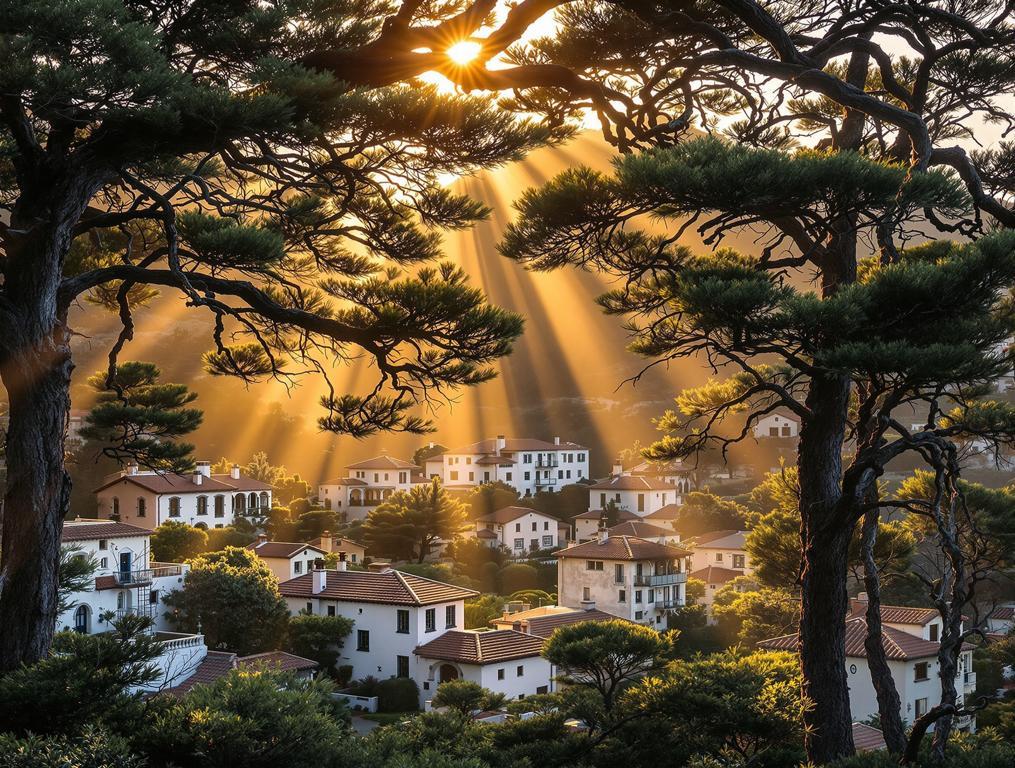The sea mist parts just enough to reveal a coastal village nestled between Highway 1 and a sloping forest of unusual pines. I’m in Cambria, California – exactly 190 miles north of Los Angeles and home to one of only three native Monterey Pine forests left on Earth. As cars zoom past toward Big Sur or Hearst Castle, I pull into this 6,000-resident haven that feels more Italian riviera than California coast.
Morning light filters through these rare pines, casting dappled shadows across weathered wooden storefronts. The Mediterranean illusion is powerful – artisan shops, coastal trails, and a pace that exists in defiance of nearby metropolises. This forest sanctuary isn’t just beautiful; it’s ecologically precious.
One of Earth’s Last Three Monterey Pine Sanctuaries
Most Highway 1 travelers never realize they’re passing through a global rarity. Cambria protects one of only three remaining native Monterey Pine forests worldwide – the others being in Monterey and Mexico’s Guadalupe Island. Unlike their cultivated cousins planted across Australia and New Zealand, these are the original genetic stock.
Walking the forest trails of Fiscalini Ranch Preserve, I notice how the pines create their own microclimate. The temperature drops about 5-7 degrees beneath their canopy. Marine fog catches in their needles, creating natural irrigation that sustains this ecosystem.
The town’s conservation ethos runs deep. Globally significant ecosystems often exist in unexpected places, like the Indonesian island that preserves a critical biological boundary.
The American Mediterranean Without the Transatlantic Flight
Cambria’s village core looks transplanted from coastal Italy – whitewashed buildings with terracotta accents, artisanal shops, and cafes with outdoor seating that spill onto narrow streets. The resemblance to Portofino isn’t coincidental.
“When the marine layer lifts and you’re sitting outside with a glass of local wine, watching the sunset over pine-topped cliffs, you’d swear you were in the Mediterranean, not California.”
“When the marine layer lifts and you’re sitting outside with a glass of local wine, watching the sunset over pine-topped cliffs, you’d swear you were in the Mediterranean, not California.”
Like certain hidden European villages with similar appeal, Cambria offers cultural richness without transatlantic jet lag. The Mediterranean comparison isn’t just aesthetic – it extends to the climate, vegetation, and lifestyle.
While more famous neighbors like Carmel-by-the-Sea have succumbed to commercialization, Cambria maintains its authentic character. Local artisans sell handcrafted jewelry, pottery, and textiles from studios where they actually create their wares.
Where Artisan Culture Meets Ecological Conservation
Ephraim Pottery West Gallery operates as a modern guild, preserving techniques that align with the town’s conservation values. This commitment to authenticity mirrors how certain Washington communities preserve their identities despite tourism.
Todd Clift’s winery began in a basement overlooking Moonstone Beach and now produces small-batch wines using fog-cooled grapes. The Friday farmers market (2:30-5:30 PM year-round) showcases local sustainable products and runs rain or shine.
Artisans incorporate native pine cones and driftwood into their work, creating a circular relationship between conservation and creation. This synergy feels increasingly rare in our hyper-commercialized world.
How to Experience This Rare Ecosystem Responsibly
The best access to Cambria’s pine sanctuary is via Fiscalini Ranch Preserve’s free trails, open daily from dawn to dusk. Morning visits offer optimal wildlife viewing and thinner crowds. While some coastal communities struggle with tourism impact, others have found sustainable solutions worth emulating.
For marine wildlife, visit Moonstone Beach between May and August when migrating whales pass close to shore. The driftwood-lined boardwalk provides easy access without disturbing delicate coastal ecosystems.
Cambria Nursery offers year-round Christmas decorations and regular workshops on using native plants in home gardens – a practical souvenir that supports conservation.
As I leave Cambria, turning north toward Big Sur, I’m struck by how completely I’d misunderstood this stretch of Highway 1. What looked like just another coastal town actually harbors one of Earth’s most precious ecosystems and a genuine cultural haven. In a California increasingly defined by crowded attractions and Instagram-famous viewpoints, Cambria’s authentic Italian spirit and rare pine forest feel like a secret too valuable to keep – yet too precious to exploit.
